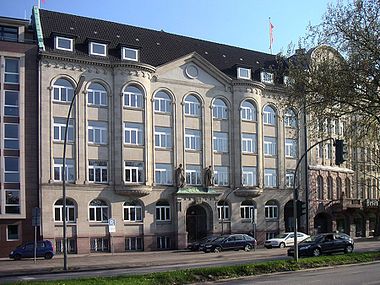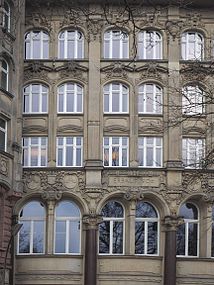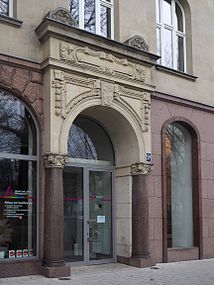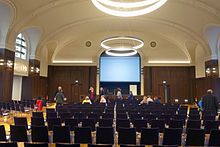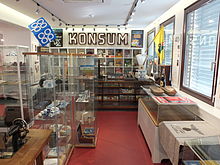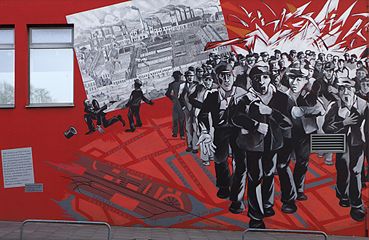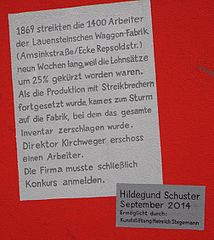Union House (Hamburg)
The union building is a building complex on Besenbinderhof in Hamburg-St. Georg (address: Besenbinderhof 56-60). The buildings are under monument protection (ID 13363 to 13367).
prehistory
Even in the year the General German Workers' Association was founded , in 1863, the idea of having its own trade union building in Hamburg emerged among members. Although the number of unions had increased over the next few years, the financial strength was not sufficient to maintain its own headquarters. The growth of the trade unions was affected by the socialist law of Bismarck "law against public danger aspirations of social democracy" of 1878. The Social Democratic Party organizations were banned and unions forced to dissolve. The Socialist Law was repealed in 1890, but the poor economic situation led to a decline in membership. The unions concentrated on advising members through the establishment of the labor secretariat on all questions of social, labor and civil law and, from 1900, they moved into offices in the privately operated restaurant “Lessinghalle” on Gänsemarkt . Since some trade unions and the Hamburg trade union cartel also had their headquarters here, the “Lessing Hall” became a central meeting point for the Hamburg workers' movement and, in a limited sense, a forerunner of the trade union building. After lengthy internal discussions about financing and a ballot, the Hamburg trade union cartel announced a competition for the architectural design of the trade union building at the end of 1904. The building was to contain offices, meeting and ballrooms, restaurant rooms and a hostel. The land and construction costs were around 1.5 million marks.
Construction and building history
The original building was built from 1904 to 1906 according to plans by Heinrich Krug and designed in baroque forms with Art Nouveau decor; the original roof of this building has not been preserved due to a later addition.
In the east followed in 1912/13 the second, stricter construction phase according to plans by Wilhelm Schröder.
During the Second World War , the trade union building was damaged and subsequently rebuilt and expanded several times. Since 2004, the exterior facade, staircases, historical stucco elements, stone reliefs and column capitals have been restored. The music hall in the original building has also been renovated since 2008.
The former administration building of the GEG ( Großeinkaufs-Gesellschaft Deutscher Consumvereine ) adjoins the union building to the east . It was built in 1906/07, also according to plans by the architect Heinrich Krug. The building is also a listed building (ID 13622).
Use and importance as a trade union building


At the opening, the SPD politician August Bebel saw the building as an “intellectual armory of the proletariat”. In the following years the trade union building became a political, social and cultural center of the German labor movement. It included several meeting rooms, offices, a library as well as a dining hall and living rooms for migrant workers. From 1918 the Workers 'and Soldiers' Council used the premises as headquarters; In 1919 the General German Trade Union Confederation moved into its headquarters at Besenbinderhof. The building was also the target of the May Day marches . The founding assembly of the Volksbühne met here in 1919 and that of the Socialist Workers' International in 1923 at the ADGB Federal Congress. On November 2nd, 1920 the GBI Großhamburger Funeral Home was founded by the trade unions, the AOK and the consumer cooperative "Produktion" . It has its seat in the union building. The Arbeiter-Radio-Bund Deutschland has carried out radio broadcasts for the workers here. From 1924, the trade union house society and the trade unions were temporarily involved in Heimstätte GmbH (135 rooms) on Nagelsweg near the trade union house to accommodate external workers.
On May 2, 1933, members of the SA , SS and NSDAP stormed the Hamburg trade union building and arrested the board members of the General German Trade Union Confederation ( ADGB ), destroyed the trade union archive and used it as the “House of Labor” as headquarters until the end of the Second World War. On May 11, 1945, immediately after the end of the war, it became the founding site of the Socialist Free Trade Union ; On September 14, 1945, Paul Bebert removed the symbols of the German Labor Front from the facade of the trade union building.
Today there are offices of the Hamburg DGB , the DGB-Bezirk Nord , the IG Metall , ver.di , IG Bergbau, Chemie, Energie , Arbeit und Leben , the DGB-Bildungswerk, the GBI Großhamburger Funeral Institute , a Hamburg cooperative museum and a cultural association. The hall, which was used by the “Theater am Besenbinderhof” until the end of the 1970s, is used for various events after renovations and renovations.
The renovation of the forecourt was completed in summer 2016. The street (now a one-way street) in front of the trade union building was connected to Repsoldstraße and the parking spaces were redesigned into green spaces.
Music hall
After 5 years of restoration, the historic music hall of the trade union building was completed in autumn 2016. Stucco ceilings , reliefs and historical tile work from the 1920s are visible again. The music hall was inaugurated for the first time in 1903. On July 8, 1963, at the time the Theater am Besenbinderhof was operating here, Dinner for One was recorded live in front of an audience. Today the music hall can accommodate up to 390 people. In 1914, the music hall of the union building had colored glass windows with revolutionary phrases. In one picture, next to a figure carrying a globe, you can see “Workers of all countries, unite!”, The last sentence from the Communist Manifesto, next to representations of the craft. Unfortunately the glass windows have disappeared.
Memorial plaques
A plaque at Besenbinderhof 60 today commemorates the occupation of 1933. Another plaque honors Barthold Heinrich Brockes . It was posted at the union building in November 2016. The garden, which Barthold Heinrich Brockes described several times in his poems, was located at the Besenbinderhof, where the union building stands today.
Pulley
In front of the union building there is half of the pulley (the other half is in Recklinghausen ), which is supposed to commemorate the “Art against Coal” campaign. In the post-war period, miners supplied the Hamburg theaters with coal for heating. As a thank you, 150 actors from the three Hamburg state theaters made guest appearances in Recklinghausen in the summer of 1947, thus establishing the Ruhr Festival . The headline on the memorial plaque next to the rope sheave in Hamburg has the following text: Rope sheave of the "König-Ludwig" founder of the Recklinghausen Ruhr Festival, which was shut down in 1965 .
Memorial plaque for Barthold Heinrich Brockes
Mural
At the corner of Repsoldstrasse and Amsickstrasse, directly behind today's trade union building, there was once a large wagon factory that produced road and rail vehicles and employed well over 1,000 workers in a wide variety of professions. A mural commemorates this factory and the nine-week strike in 1869 in which a worker was shot. The picture, completed in September 2014, can be seen from Repsoldstraße, on the wall of the western extension of the union building. It was created by the artist Hildegund Schuster , financed by the Heinrich Stegemann Art Foundation . Hildegund Schuster is a Hamburg painter and employee of the Hamburger Kunsthalle. She has painted several murals in the city of Hamburg, including 13 pictures about women's work and the change in female economic power in the Port of Hamburg.
See also
literature
- (Karl Hense) A guide through the Hamburg trade union building , Gesellschaft Handelshaus mbH, Hamburg 1914
- Heinrich Bürger : The Hamburg trade unions and their struggles from 1865 to 1890 . In addition to a graphic representation of the strikes and lockouts in the years 1885–1890. Hamburg 1899. Reprint March 2017, ISBN 9783744672566
- Heinrich Laufenberg : History of the labor movement in Hamburg, Altona and the surrounding area . Berlin 1977 (reprint of the Hamburg, Auer, 1911–1931 edition).
- DGB District Free and Hanseatic City of Hamburg: 75 Years of the Hamburg Trade Union House , publisher: DGB Hamburg
- Michael Joho: “This house should be our intellectual armory” (August Bebel) 100 Years of the Hamburg Trade Union House (1906–2006), published by DGB Hamburg, VSA-Verlag, ISBN 3-89965-211-8
- Anke Hoffsten: The People's House of the Labor Movement in Germany - Community Buildings Between Everyday Life and Utopia, Vienna, Cologne, Weimar 2017, Böhlau-Verlag, ISBN 978-3-412-50734-3 (the Hamburg Trade Union House is also a people's house)
Individual evidence
- ↑ Angelika Voß: 75 Years of the Besenbinderhof Trade Union House, in: DGB District Free and Hanseatic City of Hamburg: 75 Years of the Hamburg Trade Union House, publisher: DGB Hamburg, pp. 7-12
- ^ Ralf Lange : Architecture in Hamburg - The great architecture guide . 1st edition. Junius Verlag, Hamburg 2008, ISBN 978-3-88506-586-9 , p. 147 .
- ↑ a b Union discovers its former glory Die Welt online, April 25, 2013. Accessed January 7, 2015
- ↑ a b “New” music hall in the Besenbinderhof ( memento of the original from March 4, 2016 in the Internet Archive ) Info: The archive link has been inserted automatically and has not yet been checked. Please check the original and archive link according to the instructions and then remove this notice. Hamburger Wochenblatt online. Retrieved January 7, 2015.
- ^ Minutes of the founding meeting, Hamburger Genossenschaftsmuseum
- ^ DGB Hamburg: 75 Years of the Hamburg Trade Union House, Hamburg 1982, pp. 27–28
- ^ Franklin Kopitzsch , Daniel Tilgner (ed.): Hamburg Lexikon. 4th, updated and expanded special edition. Ellert & Richter, Hamburg 2010, ISBN 978-3-8319-0373-3 , p. 248.
- ↑ Brochure from the organizer Besenbinderhof Giffey Catering, Hamburg 2016
- ↑ Jürgen Bönig Karl Marx in Hamburg , Hamburg 2017, VSA-Verlag, pp. 159–161, ISBN 978-3-89965-751-7
- ↑ Ulrich Bauche , Ludwig Eiber , Ursula Wamser, Wilfried Weinke (eds.): We are the force - the workers' movement in Hamburg from the beginning until 1945 . Catalog book for the exhibition of the Museum für Hamburgische Geschichte, VSA-Verlag, Hamburg 1988, ISBN 3-87975-355-5 , p. 33.
- ↑ "Now we follow the bold path, who led us Lassalle", text book of a funeral for Ferdinand Lassalle , pages 28 and 29, the strike in the Lauensteinische wagon factory, publisher: Kunststiftung Heinrich Stegemann, Hamburg 2016, ISBN 978-3-739- 23003-0
Web links
Coordinates: 53 ° 33 ′ 2.9 ″ N , 10 ° 0 ′ 43.6 ″ E

